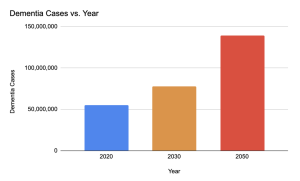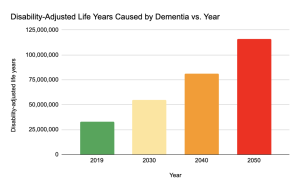By Krish Shah
From providing the ability to communicate instantaneously via call or text to life-saving medical devices, smartphones, and other electronic devices have become essential aspects of life. Thus, we must analyze and create safeguards against the impacts of increased technology usage on the brain, especially regarding the long-term psychological effects that will inevitably affect decision-making, the emotional spectrum, and social interaction.
Before delving into the consequences of increased exposure to the digital world, one must understand the inherent psychological response to increased electronic device exposure. Forgetfulness syndrome, commonly known as digital dementia, is the inability to remember, think, or make decisions in one’s daily life. This syndrome also affects memory, such as loss of short-term memory (retrograde amnesia), facts, experiences, and information, earning it the additional name of “amnestic syndrome.”5 This massive dampening of brain development from an early age develops into mild cognitive impairment (MCI), a disorder associated with symptoms such as issues with orientation, impaired concentration, and lack of self-care. Such a disorder is problematic, as research by the National Institute of Health (NIH) indicates that from 2060 to 2100, the rates of Alzheimer’s disease and related dementias (ADRD) caused by prolonged digital exposure are projected to increase four to six-fold. The aftereffects of prolonged digital exposure will potentially fuel a psychophysiological state in which the right side of the brain is used less due to decreased concentration and increased addiction, thus leading to its eventual degeneration.3 In a society where issues concerning mental health, self-care, and limited social interaction are so prevalent, it is important to note that current trends indicate that these issues may magnify at an exponential rate over future decades. We as a society must take universal and precautionary measures to understand and formulate barriers against prolonged digital media use. Such cognitive decline will be coupled with increased cases of emotional duress and abnormalities in the limbic system, which is the part of the brain responsible for the experience and expression of emotions.3 Combining these factors, digital addiction is not just a household occurrence, but a public health risk. Communities around the world are experiencing the consequences of decreased attention span, less social interaction, and degeneration of the brain, most notably with increased cases of dementia and amnesia.

Dementia Cases in the years 2020 (actual), 2030 (expected) and 2050 (expected). Dementia is projected to double every 20 years, reaching 78 million cases in 2030 and 139 million cases in 2050. For reference, there were approximately 55 million cases in the world in 2020.2
These neurodegenerative developments will dramatically impact the economic landscape, as forgetfulness syndrome will lead to a greater portion of the population developing mental disabilities, thus capping economic growth due to a reduced output globally. Currently, dementia ranks sixth in contribution to disability burdens internationally among people who are 55 or older. However, due to the aging population in both high and low-income countries, the prevalence of dementia will only increase. The burden of dementia is projected to triple over the next 30 years and become the fifth largest contributor to disability in this age group. This trend will be more concentrated in low and middle-income countries (LMICs). By the year 2050, LMICs will contribute more to the global burden of dementia than high-income nations, as they will witness 30% of the growth in dementia-related disability-adjusted life years (the number of years lost due to dementia). So, what exact effect will this have on the global economy? The natural rate of unemployment will increase due to a greater proportion of the population being disabled due to dementia. This will cause a simultaneous decrease in economic output and an increase in foregone wages. Due to these conditions being focused in LMICs, these nations will see a depleted labor force, reduced productivity due to more people taking on informal caregiving roles for loved ones, and a reduction in overall capital supply, severely decreasing global economic equality and furthering the income gaps seen in various countries.4

The graph shows the disability-adjusted life years contributed by dementia and the years associated with the numbers. Dementia contributed 33.1 million disability-adjusted life years in 2019 and is projected to contribute 55.1 million in 2030, 81.1 million in 2040, and 115.8 million in 2050.2
Although these projections may look dreary, there is still some light at the end of the tunnel. Possible solutions start at the federal government level, with each nation passing meaningful legislation that requires technology companies to strictly monitor screen time for children 16 and younger and send data to public health institutions for the government to draft appropriate legislation. This can be seen most notably with TikTok in China, where there is a 60-minute default time per day for users under the age of 18.5 Although the effectiveness of such a policy still remains to be seen, this move is still a step in the right direction as there is a precedent set about the dangers of electronic addiction.
Further, schools and learning centers must emphasize more traditional sources of learning, including activities centered around notebooks and paper to encourage students to take breaks from their screens. This will create a more natural learning environment that can be independent of the digital world. Suppose such actions are complemented by parents more vigorously setting the screen time for their children and prioritizing longer and slower-placed content. In that case, an atmosphere of individual responsibility and accountability for screen time is created, allowing children to understand the repercussions of excessive screen time from a young age. Various actions taken at the federal, educational, and household levels will allow for the proper cultivation of future generations regarding mental attributes such as increased attention span and the ability to be independent of digital technology for prolonged periods.
This may also decrease the cases of digital dementia or forgetfulness syndrome as there is a greater emphasis on utilizing the right side of the brain in memorizing information rather than relying on an electronic device, resulting in positive future economic outcomes and removing the cap to human potential.
References
- ADI – Dementia statistics. ADI – Dementia Statistics. https://www.alzint.org/about/dementia-facts-figures/dementia-statistics/#:~:text=There%20are%20over%2055%20million.
- Dementia storm on the horizon. IMF. https://www.imf.org/en/Publications/fandd/issues/2021/12/Dementia-Storm-Horizon-Counts-Nandi-Seligman-Tortorice. Published December 2, 2021.
- He Q, Turel O, Bechara A. Brain Anatomy Alterations Associated with Social Networking Site (SNS) Addiction. Scientific Reports. 2017;7(1). doi:https://doi.org/10.1038/srep45064
- Manwell LA, Tadros M, Ciccarelli TM, Eikelboom R. Digital dementia in the internet generation: excessive screen time during brain development will increase the risk of Alzheimer’s disease and related dementias in adulthood. Journal of Integrative Neuroscience. 2022;21(1):028. doi:10.31083/j.jin2101028
- Yang Z. How China takes extreme measures to keep teens off TikTok. MIT Technology Review. https://www.technologyreview.com/2023/03/08/1069527/china-tiktok-douyin-teens-privacy/#:~:text=On%20March%201%2C%20TikTok%20announced. Published March 7, 2023.